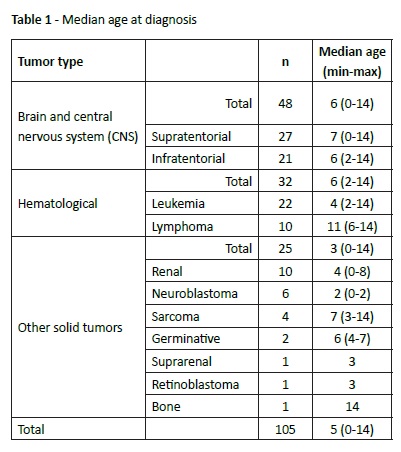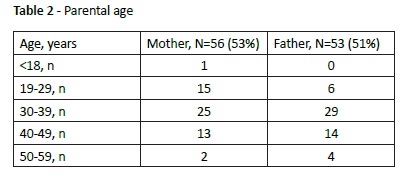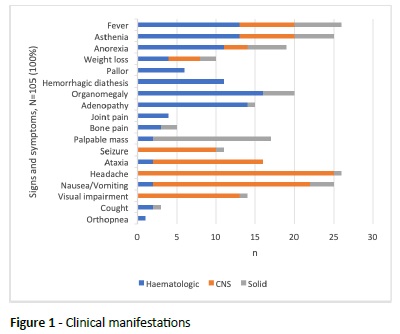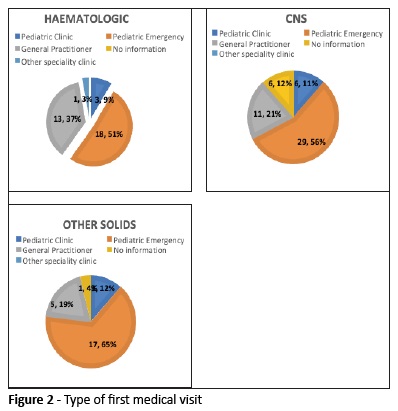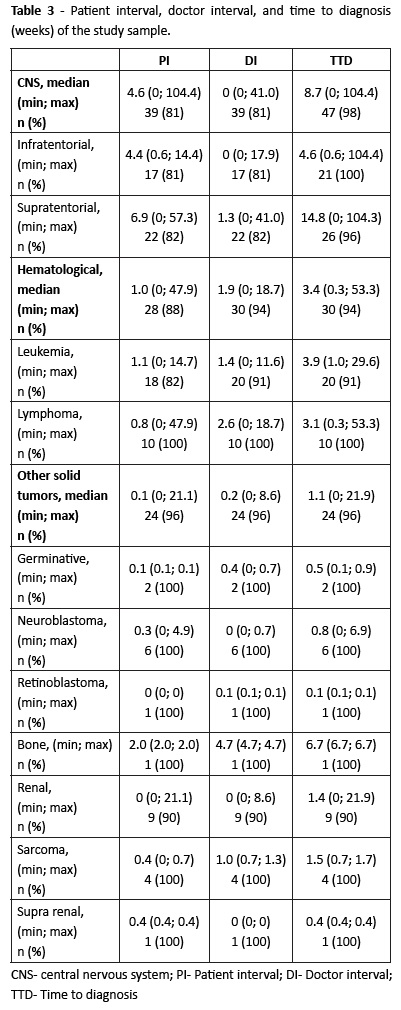Serviços Personalizados
Journal
Artigo
Indicadores
-
 Citado por SciELO
Citado por SciELO -
 Acessos
Acessos
Links relacionados
-
 Similares em
SciELO
Similares em
SciELO
Compartilhar
Nascer e Crescer
versão impressa ISSN 0872-0754versão On-line ISSN 2183-9417
Nascer e Crescer vol.28 no.4 Porto dez. 2019
https://doi.org/10.25753/BirthGrowthMJ.v28.i4.15328
ORIGINAL ARTICLES | ARTIGOS ORIGINAIS
Time to diagnosis of pediatric oncologic disease: ten-year experience from a level II Hospital
Tempo até ao diagnóstico de doença oncológica pediátrica: experiência de 10 anos de um Hospital de nível II
Inês Marques CarneiroI, Rita RamosII, Pedro FonsecaIII, Teresa MartinsIV, Filomena PereiraIV, Manuela BragaII
I Departament of Pediatrics, Lisbon Academic Medical Centre, Hospital Santa Maria, Centro Hospitalar Lisboa Norte. 1649-035 Lisboa, Portugal. inesmcarneiro@gmail.com
II Departament of Pediatrics, Hospital Garcia de Orta. 2801-951 Almada, Portugal. rita23ramos@gmail.com; manuelabraga62@gmail.com
III Center for Applied Mathematics and Economics (CEMAPRE), Lisbon School of Economics and Management (ISEG). 1200-781 Lisboa, Portugal. pedro.teles.fonseca@outlook.com
IV Department of Pediatric Oncology, Instituto Português de Oncologia de Lisboa Francisco Gentil. 1099-023 Lisboa, Portugal. tmartins.fml@gmail.com; mfpereira@ipolisboa.min-saude.pt
Endereço para correspondência | Dirección para correspondencia | Correspondence
ABSTRACT
Objectives: Despite rare, childhood cancer is a major cause of child morbidity and mortality. Reducing time to diagnosis and engaging health professionals in early treatment are key when dealing with pediatric cancer. In this study, time to diagnosis and its determinants were assessed.
Methods: A descriptive and observational study in the Pediatric Department of a Level II hospital was conducted using clinical records of children diagnosed with cancer between 2007 and 2016. Using Mann-Whitney’s test, Kruskal-Wallis’ test, and Spearman’s correlation test, differences in time to diagnosis across subgroups of children according to age, gender, parental age, type of first medical visit, and diagnosis were assessed.
Results: One hundred and five pediatric tumor cases were included in the analysis: 48 (46%) brain and central nervous system tumors, 32 (30%) hematological tumors, and 25 (24%) solid tumors. In the hematological subgroup, older age was associated with longer time to medical services demand (r=0.38, p=0.04) and children initially observed in primary health care exhibited longer time to diagnosis compared with children initially observed in Pediatric emergency services (median 1.9 vs 0 weeks, p=0.01). The median number of medical visits before the definitive diagnosis was one (min=0, max=7).
Conclusions: Differences found in time to diagnosis between different types of medical services disclose the need for improving diagnosis in the primary care setting. A high index of suspicion is mandatory, especially among adolescents, as this is a subgroup typically associated with longer times to diagnosis.
Keywords: child; neoplasm; time to diagnosis
RESUMO
Introdução: Apesar de a doença oncológica ser rara em Pediatria, é uma das principais causas de morbimortalidade. Reduzir o tempo até ao diagóstico e permitir o início precoce da terapêutica são questões prioritárias. O objetivo deste estudo consistiu em avaliar o tempo até ao diagnóstico e possíveis fatores associados.
Métodos: Foi realizado um estudo descritivo e observacional baseado na recolha de dados retrospetivos de registos clínicos referentes a casos de neoplasia diagnosticados entre 2007 e 2016 no Serviço de Pediatria de um hospital de Nível II. Foram utilizados os testes de Mann-Whitney, Kruskal-Wallis, e o teste de correlação de Spearman para avaliar a existência de diferenças no tempo até ao diagnóstico entre subgrupos de crianças definidos em função do diagnóstico, idade, sexo, idade dos pais e local da primeira observação médica.
Resultados: Foram incluídas 105 observações: 48 (46%) relativas a tumores do sistema nervoso central, 32 (30%) a tumores hematológicos e 25 (24%) a tumores sólidos. No grupo de tumores hematológicos, crianças mais velhas demoraram mais tempo a procurar serviços médicos (r=0.38, p=0.04) e crianças inicialmente observadas nos cuidados de saúde primários foram diagnosticadas mais tarde comparativamente às crianças inicialmente observadas em serviços de urgência pediátrica (mediana 1,9 vs 0 semanas, p=0,01). A mediana do número de observações médicas prévias ao diagnóstico foi de 1 (min=0; max=7).
Conclusões: As discrepâncias identificadas no tempo até ao diagnóstico entre diferentes tipos de serviços médicos revelam uma oportunidade de melhoria ao nível dos cuidados de saúde primários. Deve manter-se um elevado grau de suspeita clínica, especialmente em adolescentes, que tipicamente apresentam um tempo mais longo até ao diagnóstico.
Palavras-chave: criança; neoplasia; tempo até diagnóstico
Introduction
Although childhood cancer is rare, it is a major cause of child morbidity and mortality and the first cause of death (after accidents) in childhood and adolescence.1,2 According to a recently published report about the international incidence of childhood cancer, the most prevalent type of cancer in children until the age of 14 is leukemia, followed by central nervous system (CNS) tumors, and lymphomas, with lymphomas, epithelial tumors, and melanomas being the most frequent tumors in children aged between 15 and 19 years.3 In Europe, recent data revealed an average age-standardized annual incidence of 137.5 per one million individuals (95% confidence interval [CI] = 136.7; 138.3) and an increased incidence of 0.54% per year in children up to 14 years of age (95% CI = 0.44; 0.65).4 Instituto Português de Oncologia de Lisboa Francisco Gentil (IPOLFG) is the reference center for Pediatric Oncology in the South of Portugal, Azores, Madeira, and also in Portuguese-speaking African countries. IPOLFG has between 150 and 200 new cases every year.5 The overall five-year survival rate for childhood cancer is approximately 80%.2 Reducing time to diagnosis (TTD) and engaging professionals on early treatment are key when dealing with pediatric cancer.6 However, shorter times to diagnosis are not always associated with better outcomes, since many other factors, including tumor biology, contribute to disease progression.1,6 Nevertheless, minimizing family anxiety, establishing an accurate diagnosis, and performing an early referral to an Oncology center for treatment to be started as soon as possible should be a priority.7,8 Median time to diagnosis varies widely among tumor types.1 Longer times to diagnosis are typically associated with brain, bone and germ cell tumors, and retinoblastoma, while shorter times are mostly associated with leukemia and renal tumors.1,7 Patients’ age is also associated with TTD: older children usually exhibit longer TTD due to reduced parental surveillance, reduced proximity to the health care system, and the reluctance of adolescents in disclosing their symptoms.1,6,7 The nature of the first symptoms to be disclosed and tumor location are also associated with TTD, since nonspecific signs may contribute to longer TTD.6 Most initial clinical manifestations are nonspecific, and a high index of suspicion is necessary to establish the diagnosis, especially when facing persistent symptoms, even with a regular first workup.7 Studies addressing cancer diagnosis in the Portuguese pediatric population are currently lacking. In this study, the authors aimed to evaluate how medical services manage certain types of childhood cancer and assess which factors are associated with longer and shorter times to diagnosis.
Materials and methods
An observational, descriptive study was conducted in the Pediatric Department of Hospital Garcia de Orta (HGO). HGO’s pediatric database was reviewed to identify every child with a cancer diagnosis between January 2007 and December 2016. Information regarding the definitive diagnosis was obtained through IPOFLG’s database. As until 2015 the age limit of HGO’s Pediatric Department was 15, children aged between 15 and 18 years old were excluded. Patients with genetic diseases like neurofibromatosis and tuberous sclerosis were also excluded since many such children attend routine laboratory surveillance and imaging for neoplasms. Admissions regarding tumor relapse were also excluded. Information was collected through informatic medical records. Data retrieved included demographic features of patients and parents, signs and symptoms, time between symptom onset and diagnosis, number of medical visits, place of the first medical examination, and diagnosis (using the International Classification of Childhood Cancer, 3rd edition). In cases in which the date of symptom onset was missing or incomplete, the longest time duration was considered (for instance, if only information regarding month was available, the first day of the month was considered). TTD was defined as the time period between initial symptom onset and diagnosis, patient’s interval (PI) as the time between initial symptom onset and first clinical examination, and doctor’s interval (DI) as the time between first clinical appointment and diagnosis. Differences in TTD, PI, and DI across children subgroups according to age, gender, parental age, diagnosis, and type of the first medical visit were assessed through the Mann-Whitney’s U-test, Kruskal-Wallis’ Rank Sum Test, and Spearman’s correlation test. All statistical tests were conducted at a 0.05 significance level.
Results
Demographic Features
A total of 105 pediatric tumor cases were analyzed: 48 (46%) brain and central nervous system tumors, 32 (30%) hematological tumors, and 25 (24%) solid tumors. Median age at diagnosis was 5 years (min: 1 month, max: 14 years) and 64 (67%) individuals were male (Table 1). The distribution of parental age is presented in Table 2. Sixteen (15%) children were from families with at least one case of neoplastic disease and no children had previously had a malignant condition.
Clinical manifestations
Figure 1summarizes initial clinical manifestations across different tumor subgroups. Most children with CNS tumors claimed to suffer from headaches (52%), nausea and/or vomiting (42%), ataxia (29%), and visual changes (27%). Infratentorial tumors primarily manifested through headaches (74%), nausea and/or vomiting (65%), and ataxia (57%), while supratentorial tumors were mostly associated with visual changes (36%), convulsions (36%), and headaches (32%). In three cases, brain tumor diagnosis was established following epilepsy acknowledgment. Lymphadenopathy was the most prevalent lymphoma sign (80%). The most frequent signs among children with leukemia were organomegaly (59%), fever (50%), and hemorrhagic diathesis (46%), while the most frequent signs in children with solid tumors were presence of a mass (60%) and fever (24%). Lethargic behavior was identified in 41% of children with hematological neoplasms, 15% of children with CNS tumors, and 20% of children with solid tumors.
Time to diagnosis (TTD)
Fifty-five percent of children were initially observed by a specialist at the Pediatric Emergency Department, 27% by a general practitioner, 11% by a private pediatrician, 1% by another medical specialist, and 6% had no information available. Twenty-six patients (25%) were referred to HGO by another Pediatric Emergency Centre: 25 (52%) of these patients had a CNS tumor and 1 (4%) had a solid tumor. The distribution of first medical visits according to different diagnostic subgroups is presented in Figure 2. The median number of medical visits previous to diagnosis was 1 (min = 0, max =7) for all subgroups. The three patients that were firstly diagnosed with epilepsy were not included in the analysis, as they went through multiple scheduled medical appointments.
TTD, PI, and DI according to disease category are depicted in Table 3. TTD in the brain tumor group was longer compared with the hematological tumor group (8.7 vs 3.4 weeks, p<0.01) and with the other solid tumor group (8.7 vs 1.1 weeks, p<0.001). Approximately 83% of infratentorial tumors were diagnosed in the first medical visit. The supratentorial tumor with the longest DI corresponded to a female adolescent who was first diagnosed with migraine. She suffered from headaches for almost one year, with progressive worsening of pain and vomits. Brain tumor diagnosis was reached one week after onset of ataxia and leg weakness. The longest DI in the leukemia group corresponded to a child with intermittent fever and gait claudication who was observed in the Pediatric Emergency Department and showed normal physical exams, blood tests, and hip and knee x-rays. The patient’s general condition eventually aggravated over time. At the time of diagnosis, hepatosplenomegaly and petechial exanthem were identified, and blood tests revealed anemia, thrombocytopenia, and blasts in the peripheral blood smear. The longest DI in the lymphoma group was the case of a child with parotid enlargement, who initially exhibited normal imaging and blood tests and was diagnosed after the mass became painful and started exhibiting inflammatory signs, with no response to antibiotic treatment.
Except for the hematologic group, we found no differences in PI, DI or TTD across patient subgroups differing by gender, age, parents’ age or familiar history of malignant diseases. In the haematologic group, we found a positive correlation between PI and patients’ age, which means that longer PIs were mostly associated with older children and shorter PIs with younger children (r=0.38; p=0.04 -table 4), and between PI and parents’ age: longer PIs were positively correlated with both mother’s age (r=0.74, p<0.001) and father’s age (r=0.58, p=0.03). Shorter DIs occurred more often with patients whose first medical appointment was at the paediatric emergency department rather than at the primary care centre (median: 0 weeks vs 1.9 weeks, p=0.01). In what respects to PI or TTD, we found no significant differences across subgroups differing by type of first medical visit (table 5).
Discussion
Diagnosing childhood cancer in its early stages may be difficult because of its rarity and due to the nonspecific nature of some of its signs and symptoms that can mimic more common paediatric diseases.6 A high degree of suspicion is needed in order to make the correct diagnosis, and there are some specific alert signs that should not be missed. Headaches, for example, are a frequent complaint during childhood, but some other signs like progressive headaches or changes in its typical features, nocturnal arousal, matinal vomiting, and altered neurologic examinations should raise clinical suspicion.10 Despite the fact that the classic triad of headache, vomiting, and papilledema is only present in a minority of the patients, every pediatrician should be trained to rule out papilledema through fundoscopic examination.10,11 Other possible clinical manifestations of neoplastic diseases include unexplained fever, pallor and/or loss of energy, sudden tendency to bruise, lymphadenopathies or presence of a mass, and persistent localized pain or limping.2 Another red flag for neoplastic disease is persistence of signs and symptoms over time, even after an unremarkable first examination.10 Furthermore, parental perception of subtle changes in children’s behavior should not be underestimated.10,12
Findings from this study are consistent with those from previous studies in that the group of brain tumors displayed the longest TTD.1,12 This study also shows that PI tends to be longer for children initially observed at the General Practice compared with those initially observed at the Pediatric Emergency Department.7,8 This can be explained by several factors, namely by the fact that in cases with more severe clinical signs parents typically go directly to the Pediatric Emergency Department. It is well documented that more aggressive and rapidly growing tumors, which manifest quickly, are easier to diagnose.7 Also, laboratory and imaging exams are easily accessible in the Pediatric Emergency Department, which allows a faster diagnosis. On the other hand, longer TTD has been found to be associated with more insidious slow growth manifestations and less aggressive tumor subtypes.7
In this sample, the number of clinical appointments attended before the definitive diagnosis was mostly small. The reduced number of medical visits prior to diagnosis evidences that a well-established referral network is in place. However, the longer TTD identified in children that were initially observed at the General Practice shows there is room for improvement regarding diagnostic tools in the Primary Care setting. On the other hand, open access to the Emergency Department was found to be beneficial.
In the hematological group, older patients were found to have significantly longer PIs compared to younger counterparts. Adolescents have been described as a risk subgroup associated with longer PIs due to less frequent contact with medical appointments and to a greater reluctance in disclosing symptoms.11 Parental age and educational level have been previously identified as factors influencing family behavior regarding recognition of neoplastic symptoms.6 In this study, a positive correlation was found between parental age and longer PI in the subgroup of patients with hematological tumors, although the reduced sample size does not allow for definitive conclusions.
Due to this study’s retrospective nature and to the fact that HGO comprises a reference neurosurgical center responsible for increasing the total number of CNS tumors referred from other Pediatric Emergency Departments, this sample may have been biased. Consequently, population-based studies are required before conclusions retrieved from this study can be generalized.
Diagnosis of neoplastic conditions in the Pediatric population is challenging for both families and the health system. A high index of suspicion is required for diagnosis not to be missed when clinical manifestations arise. Once diagnosis is established, prompt referral to an Oncology Centre should be a priority.
REFERENCES
1. Lethaby CD, Picton S, Kinsey SE, Phillips R, van Laar M, Feltbower RG. A systematic review of time to diagnosis in children and young adults with cancer. Arch Dis Child. 2013; 98:349-55. DOI: 10.1136/archdischild-2012-303034. [ Links ]
2. Ward E, Desantis C, Robbins A, Kohler B, Jemal A. Childhood and Adolescent Cancer Statistics , 2014. Ca Cancer J Clin. 2014; 64:83-103. DOI: 10.3322/caac.21219. [ Links ]
3. Steliarova-Foucher E, Colombet M, Ries LAG, Moreno F, Dolya A, Bray F, et al. International incidence of childhood cancer, 2001-10: a population-based registry study. Lancet Oncol. 2017; 18:719-31. DOI: 10.1016/S1470-2045(17)30186-9. [ Links ]
4. Steliarova-Foucher E, Fidler MM, Colombet M, Lacour B, Kaatsch P, Piñeros M, et al. Changing geographical patterns and trends in cancer incidence in children and adolescents in Europe, 1991-2010 (Automated Childhood Cancer Information System): a population-based study. Lancet Oncol. 2018; 19:1159-69. DOI: 10.1016/S1470-2045(18)30423-6. [ Links ]
5. Lacerda AF, Neto A, Teixeira A, Costa C, Pedroso E, Pereira F, et al. A Criança Com Doença Oncológica - Guia de Apoio Para Os Serviços de Pediatria. Serviço de Pediatria Instituto Português de Oncologia de Lisboa Francisco Gentil, EPE.; 2007. [ Links ]
6. Dang-Tan T, Franco EL. Diagnosis delays in childhood cancer: A review. Cancer. 2007; 110:703-13. DOI: 10.1002/cncr.22849. [ Links ]
7. Brasme JF, Morfouace M, Grill J, Martinot A, Amalberti R, BonsLetouzey C, et al. Delays in diagnosis of paediatric cancers: A systematic review and comparison with expert testimony in lawsuits. Lancet Oncol. 2012; 13:e445-59. DOI: 10.1016/S1470-2045(12)70361-3. [ Links ]
8. Barr RD. “Delays” in diagnosis: a misleading concept, yet providing opportunities for advancing clinical care. J Pediatr Hematol Oncol. 2014; 36:169-72. DOI: 10.1097/MPH.0000000000000108. [ Links ]
9. Nazemi KJ, Malempati S. Emergency Department Presentation of Childhood Cancer. Emerg Med Clin North Am. 2009; 27:47795. DOI: 10.1016/j.emc.2009.04.008. [ Links ]
10. Arnautovic A, Billups C, Broniscer A, Gajjar A, Boop F, Qaddoumi I. Delayed diagnosis of childhood low-grade glioma: causes, consequences, and potential solutions. Child’s Nerv Syst. 2015; 31:1067-77. DOI: 10.1007/s00381-015-2670-1. [ Links ]
11. Mehta V, Chapman A, McNeely PD, Walling S, Howes WJ. Latency Between Symptom Onset and Diagnosis Pediatric Brain Tumors: An Eastern Canadian Geographic Study. Neurosurgery. 2002; 51:365-73. DOI: 10.1227/01.NEU.0000019779.27789.AC. [ Links ]
Endereço para correspondência | Dirección para correspondencia | Correspondence
Inês Marques Carneiro
Departament of Pediatrics
Lisbon Academic Medical Centre
Hospital Santa Maria
Centro Hospitalar Lisboa Norte.
Av. Professor Egas Moniz 1649-035 Lisboa
Email: inesmcarneiro@gmail.com
Received for publication: 02.11.2018
Accepted in revised form: 11.09.2019













